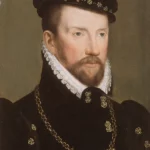
Jacqueline Montbel D’Entremont
Date of Birth
February 26, 1541
Place of Birth
Rhone-Alpes, Isere, France
Towns / Cities Moved Into
Rhone-Alpes, Isere, France
Known Occupation
Buttet's muse
Religion
-
Death Information
Year of death
July 6, 1600
Place of death
Rhone-Alpes, France
Cause of death
-
Obituary

Parents

Sebastian D'Entremont

Beatrix D'Entremont
Marital Status


Married Gaspard De Coligny
March 25 1571
La
Rochelle, Nouvelle-Aquitaine, France
Children


Narrative / Story
In the serene landscapes of Rhône-Alpes, Isère, France, the year 1541 heralded the birth of Jacqueline Montbel D’entremont into a world of nobility and impending turmoil. Born into a prominent family, her life was a tapestry of privilege, set against the backdrop of the complex socio-political landscape of 16th-century France. As a young girl, Jacqueline’s days were spent within the aristocratic circles of the royal court, where she served as a maid of honor to Princess Marguerite of France. This role not only offered her a glimpse into the intricacies of court life but also prepared her for the challenges that lay ahead.
As Jacqueline matured into a young woman of twenty, the question of her marriage became a pivotal issue, intertwined with the strategic interests of her family. Her matrimonial prospects were not just a matter of personal choice but a chess move in the grand game of power and alliance. Despite her father’s intentions to align her with a Savoyard noble, her mother’s preference leaned towards Claude de Bastarnay, a relative of the esteemed Diane de Poitiers. However, Jacqueline’s significant wealth and influence complicated these plans, attracting the attention of the Duke of Savoy, who sought to keep her fortune within his realm. In a turn of events, King Charles IX’s intervention led to her marriage with Samuel Guichenon on February 16, 1561.
The union, however, was marred by the shadow of the Wars of Religion, with Guichenon actively participating as a Catholic. Their marriage, devoid of the joy of children, was short-lived as Guichenon fell at the Battle of Saint-Denis, fighting for the Catholic cause. This loss plunged Jacqueline into a period of reflection and reevaluation.
In the wake of her husband’s death, Jacqueline’s path intersected with Theodore de Bèze, a prominent French Protestant theologian. His influence and guidance led her to the arms of Gaspard II de Coligny, the Admiral of France and a renowned Huguenot leader. Their marriage in 1571, shrouded in secrecy and defiance of the Duke of Savoy’s prohibitions, was a bold affirmation of love and shared faith. The ceremony in La Rochelle, graced by the presence of influential figures like Jeanne d’Albret and Henry of Navarre, marked the beginning of a partnership that would weather the storms of religious and political strife.
Jacqueline’s life was increasingly entwined with the turbulent French Wars of Religion. Her marriage to Coligny not only solidified her position within the Protestant movement but also heightened tensions with the Duke of Savoy. The accusation of demonic possession against her daughter Marguerite and the subsequent charges of witchcraft against Jacqueline herself were reflective of the era’s fraught religious atmosphere. Although she was cleared of the charges of sorcery, the shadow of treason loomed large, leading to her imprisonment in the Moncalieri fortress in Turin.
Throughout her incarceration, efforts were made by King Henry IV of France to secure her release, but to no avail. Jacqueline’s life, thus, became emblematic of the broader socio-economic and religious conflicts of her time. As a noblewoman and the wife of a prominent Huguenot leader, she faced discrimination and persecution, her life choices being a mirror to the tumultuous era she lived in.
Jacqueline Montbel D’entremont’s story is a poignant narrative of courage, determination, and resilience. Her journey through the treacherous landscape of religious conflict and political intrigue is a testament to the enduring strength of the human spirit. Her legacy, marked by personal sacrifice and steadfastness in the face of adversity, continues to inspire. It serves as a powerful reminder of the challenges and triumphs faced by those who dared to stand firm in their beliefs during one of the most turbulent periods in history. Her life, a blend of grace under pressure and unwavering courage, remains a captivating chapter in the annals of the past, resonating with those who seek to understand the complexities of human endurance and the indomitable will to persevere.